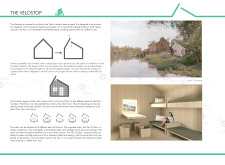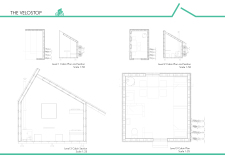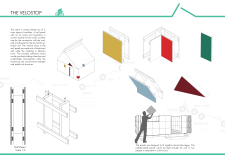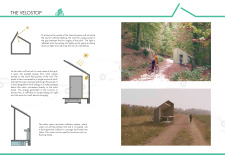5 key facts about this project
The Velostop is a rest area created for cyclists using the Velo 6 route. Located in an area that encourages outdoor activities, the structure aims to provide a space for relaxation and respite. Its design focuses on adaptability and functionality, offering a compact solution that responds to the needs of travelers while enhancing their experience.
Modularity and Flexibility
The design incorporates a modular approach that allows for easy assembly with identical components. This feature enables quick construction and makes it possible to customize the structure by adding or removing sections. The compact footprint, measuring 20 square meters, maximizes available space, allowing for various configurations based on user needs.
Structural Composition
The cabin has a pitched roof that draws from traditional gable architecture, while an innovative angle introduces a glass plane. This glass element brings natural light into the interior, reducing the need for artificial lighting. The main structure is built with vertical hardwood oak studs, which are complemented by Siberian larch cladding. This combination offers both strength and a warm, inviting appearance.
Functional Configurations
The Velostop can be realized in several functional variations. The Tier 3 Cabin includes key amenities such as a bathroom, four bunk beds, a kitchenette, and integrated seating with storage. A simpler Tier 2 version includes a fireplace and seating, while the most basic Tier 1 option provides an open shelter with seating and bike racks. Each configuration serves to meet the diverse requirements of cyclists.
Sustainability Features
In line with modern sustainability practices, the Velostop features solar panels installed on the south-facing roof. This allows the structure to collect energy that powers its lighting and charging stations. The design also includes a rainwater collection system that channels water from the roof into a storage tank, enabling its reuse for practical applications like flushing toilets.
The glass panel strategically placed in the roof reflects light onto the ceiling, enhancing the sense of space and brightness within the compact cabin.





















































